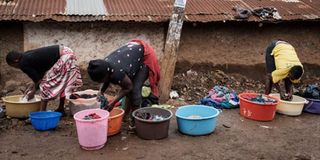Covid-19 to push 34 million women into abject poverty

Women washing clothes at Kibra slums in Nairobi. A report by UN says 34 million women and girls in Sub-Saharan Africa could live in abject poverty by 2030.
What you need to know:
- Some 34 million women and girls in Sub-Saharan Africa could live in abject poverty in the next decade as a result of effects of Covid-19.
- Number of women and girls living in extremely poor households expected to rise from 249 million to 283 million.
- Covid-19 put a stop to schooling and this has led to rise in teenage pregnancies.
- Report says more than 11 million girls from pre-primary to tertiary education at risk of not returning to school.
Some 34 million women and girls in Sub-Saharan Africa could live in abject poverty in the next decade as a result of effects of Covid-19, according to new data on empowerment interventions.
Between 2021 and 2030, the number of women and girls living in extremely poor households is expected to rise from 249 million to 283 million, UN Women and UN Department of Economic and Social Affairs found in their joint report Progress on the Sustainable Development Goals: The Gender Snapshot 2020 report.
Worryingly, by 2030, this region will be home to 71 per cent of women and girls living in extreme poverty globally.
The pandemic is causing resurgence in extreme poverty as it has disrupted efforts towards eradicating poverty and inequality with the women and girls being the most affected, the report says.
Unpaid care
“Already, women are more likely than men, to live in extreme poverty. As the crisis exacerbates labour market instabilities along with gender inequalities in access to economic resources and in the division of unpaid care and domestic work, many more women are expected to fall into destitution,” states the report.
Covid-19 put a stop to schooling and this has a greater effect on the girls, including rise in teenage pregnancies with some defiled, engaged in teen relationships or exchanged sex to satisfy a pressing need such as food and sanitary towels.
In the face of these, the girls will be left behind in education as the report finds that more than 11 million girls from pre-primary to tertiary education are at risk of not returning to school.
Their chances are further narrowed as some countries such as Tanzania have imposed prohibitive policies banning pregnant adolescents or teen mothers from attending school.
Routine health services
The report signals ending preventable maternal deaths by 2030 as an unlikely achievement as it stands now.
This is because the pandemic has placed significant stress on the health systems causing not only disruption to routine health services, but also altering the health-seeking behaviour of most women.
In Kenya, for instance, the media has covered expectant women who preferred to deliver at home for fear of contracting the virus in hospitals. Others were forced to give birth without skilled attendants as they got into labour during curfew hours and hence, could not travel to nearest health facility.
In the prevailing circumstances, the report says, the world is expected to fall short of the target by more than one million lives.
Equality programs
Of concern is that gender equality programs are still heavily underfunded as they receive only four per cent of the bilateral aid.
Data from Organisation for Economic Co-operation and Development (OECD) shows that allocation dedicated to gender equality programs remains very low at four per cent.
At the same time, bilateral aid that is gender-blind is far high, standing at 62 per cent.
Already, the UN leadership is concerned about the slow pace recorded in progress towards promoting women empowerment.
“Change is coming at a pace that is too slow for the women and girls whose lives depend on it, and for the effectiveness of our efforts to maintain international peace and security,” said UN Secretary-General Mr António Guterres on October 29, during the annual UN Security Council Open Debate on Women, Peace and Security.
Peace initiatives
He said a paltry 0.2 per cent of bilateral aid to fragile and conflict-affected situations goes to women organisation, which essentially support local women’s peace initiatives and indigenous processes for conflict resolution.
And this backtracks efforts towards fulfilling commitments contained in the UN Security Council Resolution 1325 (UNSCR 1325) on women, peace and security.




